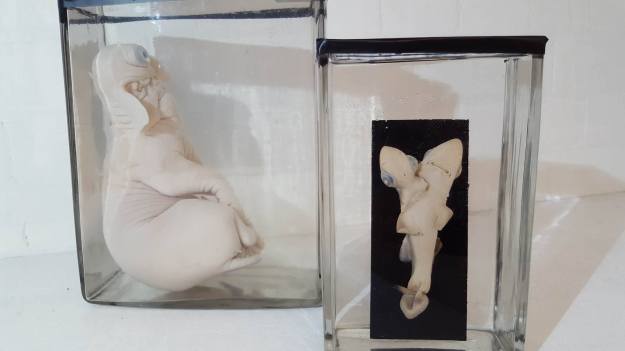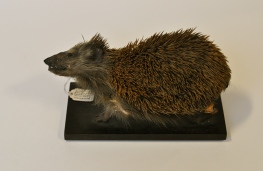On the 16th February, the ‘History and Philosophy of Science in 20 Objects’ lecture series held its second event, featuring monsters. PhD student Laura Sellers introduced a large audience to a member of the Museum of HPS’s wet specimen collection: a two-headed shark (spiny dogfish, or Squalus acanthias). The spiny dogfish is an intriguing animal in its own right. Possessing two spines, when attacked the dogfish is able to flex its back to allow one to protrude as a venomous spike. Yet it was the two heads of this specimen (the result of gene overexpression) under examination.

The two-headed fish (right) and a one-eyed piglet (left). The two heads of the fish are the result of gene overexpression. The one eye of the piglet results from gene underexpression.
Emeritus fellow Dr. Jon Hodge began his lecture with an important caveat. Historians of science have long sought to overcome a temptation to tell history as a story of the triumph of modernity over traditional ways of thinking. Yet a tension runs throughout the Western history of monsters, namely between nature as studied by science and nature as interpreted as the art of god by religious traditions.
So how has the emergence of monsters been explained throughout history? Aristotle (384-322BC) viewed all natural objects as a synthesis of form and matter. Form usually imposed itself upon matter, for example turning an acorn into an oak rather than a beech tree. Monsters occurred when matter deviated from form.
Nearly two millennia later, René Descartes (1596-1650) applied his mechanical view of nature – consisting of matter plus laws of motion – to life. Rare movements accounted for the development of monsters. Yet only a generation later, the mechanical view of nature was considered inadequate to explain life: contemporaries instead turned to the divine. A popular idea was the so-called “box-within-a-box” theory; the idea that god had created all forms of life at the first moment of creation, with later forms hidden within the first plants and animals.

The “box within a box” theory was illustrated with a comparison to nesting dolls. Image from http://legomenon.com/russian-matryoshka-nesting-dolls-meaning.html
In the early nineteenth century this theory was confronted by French morphologist Étienne Geoffroy Saint-Hilaire (1772-1844). Geoffrey experimented with animal embryos – shaking, heating or prodding them – and observed the emergence of monstrous characteristics. External influences could apparently change animals from one generation to the next.
Subsequent years saw monsters fall in and out of scientific fashion. Charles Darwin did not discuss monsters as a means of variability (1809-1882). But from the 1880s-1920s biology took a laboratory turn and adopted saltationism. Richard Goldschmidt (1878-1958) devised the theory of “hopeful monsters”: or viable deviations with an evolutionary future. Yet Ernst Mayr (1904-2005), one of the founders of the modern synthesis, thought Goldschmidt harkened back to traditional, discredited views from Plato and Aristotle. Taking a difference stance (1941-2002) was Stephen Jay Gould, who championed Geoffroy. Monsters have lived on into what we think as of modern science.
Simply put, all this reveals that straightforward, traditional to modern narratives don’t hold up. History is complex and scepticism of simple stories is part and parcel of the historians’ trade.
A video of the full lecture can be accessed at https://arts.leeds.ac.uk/museum-of-hstm/20objects/object-2-two-headed-fish/
Matthew Holmes










